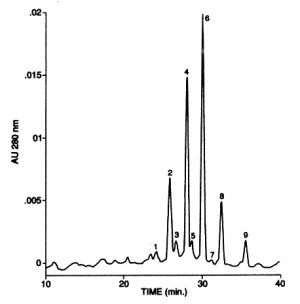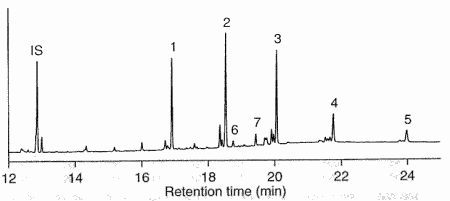
A determination of the total content of resorcinol lipids may be done according to a colorimetric method using the diazonium salt Fast Blue B (Tluscik F et al., Acta Soc Bot Pol 1981, 50, 645). The intensity of the reaction between alkylresorcinols and Fast Blue B is independent of the length of the alkyl side chain, which ranges from 15 to 25 carbon atoms. An improvement of that procedure has been reported (Gajda A et al., J Food Comp Anal 2008, 21, 428).
Sensitive and accurate HPLC and GC methods of analysis for the determination of individual alkylresorcinols have been described. We have selected one simple and precise method for each technical approach.
(Mullin WJ et al., J Agric Food Chem 1992, 40, 2127)
Extraction
A 1-5 g grain sample is extracted with 50 ml of acetone by stirring overnight at 25°C.
The filtered solvent is evaporated and the residue redissolved in 25 ml methanol and filtered through a 0.45 mm filter.
HPLC conditions
A RP 18 spheri-5 column (4.6 mm x 25 cm) is used with a UV detector set at 280 nm.
The solvent gradient was as follows :
solvent A : water
solvent B : methanol
solvent C : hexane
| Time (min) | A | B | C |
| 0 | 25 | 75 | 0 |
| 5 | 25 | 75 | 0 |
| 20 | 0 | 100 | 0 |
| 30 | 0 | 100 | 0 |
| 35 | 0 | 95 | 5 |
| 40 | 0 | 100 | 0 |
| 45 | 25 | 75 | 0 |
A stock solution of recrystallized pentadecylresorcinol (Aldrich Chem Co) in methanol (1 mg/ml) was used to prepare a calibration curve (0.1-0.5 mg/injection). As an example, a chromatogram of wheat cereal is shown below (Mullin WJ et al., J Agric Food Chem 1992, 40,2127)

The peaks 1, 2, 4, 6, 8, and 9 are attributable to C15, C17, C19, C21, C23, and C25 resorcinols, respectively
The minor peaks (3, 5, and 7) are attributed to alkenylresorcinols.
Calibration curves made with each homologues should be prepared on the basis of the molar fraction of the alkylresorcinols present, similarly to the quantitation of phospholipids via phosphorus determination (Kulawinek M et al., J Food Lipids 2008, 15, 251).
Alk(en)ylresorcinols may be purified by TLC before HPLC (Kozubek A et al., Chem Phys Lipids 1995, 78, 29).
Separations are performed using silica gel 60 plates developed with chloroform/ethyl acetate (85/15, v/v). Bands of separated phenolic components are visualized by spraying plates with 0.05% aqueous Fast Blue B (Serva). Alk(en)ylresorcinols are located in a band appearing violet with a Rf of about 0.27. The components are recovered by extraction with diethyl ether which is evaporated before further analysis.
Calibration curves made with each homologues should be prepared on the basis of the molar fraction of the alkylresorcinols present, similarly to the quantitation of phospholipids via phosphorus determination.
In the following method, a fast and easy analysis of alkylresorcinols in cereals is described (Ross AB et al., J Sci Food Agric 2001, 81, 1405).
Extraction
Whole grains or flour (1 g) was extracted for one day with 40 ml of ethyl acetate containing 0.5 mg of C22:0 as internal standard. Aliquots (4 ml) were used for direct GC analysis.
GC analysis
1 ml of extract without previous derivatization was injected into a BP-5 capillary column (25 m, inner diameter 0.3 mm). The injector and detector temperatures were 325 and 350°C, respectively. Separation was performed under the following temperature program : 120°C (0 min), 200°C (5 min), 320°C (20-35 min).

IS, internal standard; peak 1, C17:0; peak 2, C19:0; peak 3, C21:0; peak 4, C23:0; peak 5, C25:0
A rapid gas chromatography coupled with mass spectrometry method appplied to the analysis of human plasma has been reported (Landberg R et al., Anal Biochem 2009, 385, 7).
Devenez membre et participez au développement de la Lipidomique au XXIème siècle.
S'inscrire